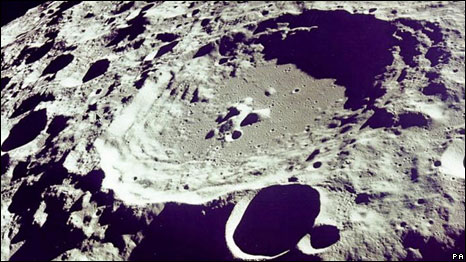Second Moon 地球或許曾有兩個(gè)月亮
Second Moon 地球或許曾有兩個(gè)月亮
By Matt McGrath, BBC News

The theory might explain the type of terrain seen today on the surface of the Moon
媒體英語(yǔ)會(huì)帶大家一起學(xué)習(xí) BBC 撰稿人在報(bào)道世界大事時(shí)常用到的單詞和短語(yǔ)。
Background: 科學(xué)雜志《自然》上的一項(xiàng)新的研究報(bào)告認(rèn)為地球可能曾經(jīng)擁兩個(gè)月亮,不過(guò)在天體碰撞后,比較小的一個(gè)消失了。科研人員認(rèn)為,碰撞過(guò)程可能相當(dāng)緩慢導(dǎo)致月球上出現(xiàn)了鮮為人見(jiàn)的凹凸不平的高地結(jié)構(gòu)。
收聽(tīng)與下載
This new theory builds on the idea that around four billion years ago the Earth was struck by a Mars-like planet, but instead of the smash producing enough debris for one moon, this paper argues there was enough for two.
This small second moon become stuck in a gravitational tug of war between the Earth and its much larger sibling. After millions of years in this position the new moon was drawn into a collision at a speed of less than three kilometres per second.
The scientists say this slow paced crash may have caused a build up of material and the formation of highlands on the Moon's far side.
For decades scientists have been trying to understand why the visible near side of the Moon is covered in craters while the far side has mountain ranges higher than 3,000 metres.
The researchers hope that Nasa observational missions might prove this new theory within a year.
Glossary 詞匯表 (收聽(tīng)發(fā)音, 請(qǐng)單擊英語(yǔ)單詞)
- to be struck by被撞擊
- a smash 沖擊
- debris碎片;廢墟
- a paper 學(xué)術(shù)文章報(bào)告
- to become stuck被阻無(wú)法移動(dòng)
- a gravitational tug of war天體碰撞
- a sibling姊妹(類(lèi)似天體)
- slow paced慢速
- the far side遠(yuǎn)處
- crater火山口
相關(guān)鏈接
- DNA diagnosis revolution 基因研究帶來(lái)診斷革命
- Squirrels are 'climate culprit' 松鼠是"氣候變化的罪魁禍?zhǔn)?
- Door opens for new Olympic sports 為新運(yùn)動(dòng)項(xiàng)目敞開(kāi)奧運(yùn)大門(mén)
- HIV evolving 'into milder form' 艾滋病毒“毒性”減弱
- EU investment plan 歐盟主席公布巨額投資方案重振歐盟經(jīng)濟(jì)
- UK to lead Moon landing in 10 years 英國(guó)牽頭十年登月計(jì)劃